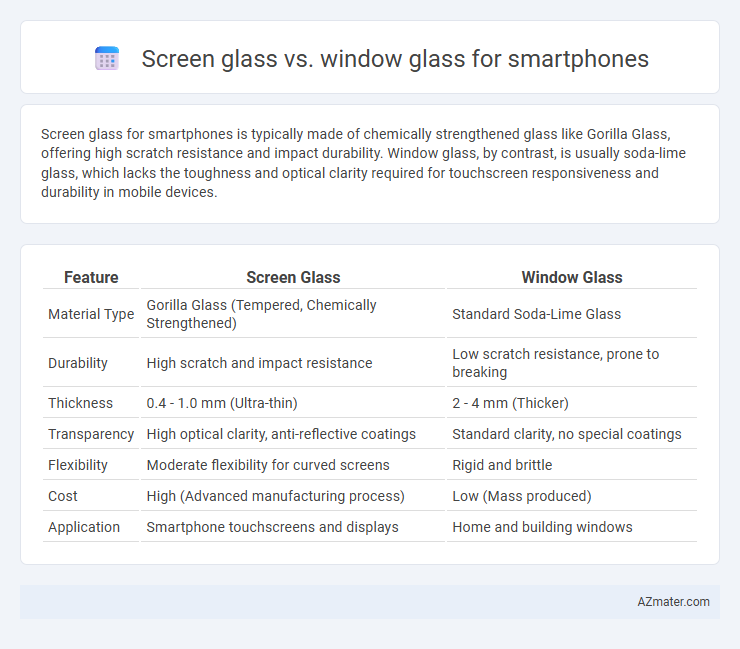Screen glass for smartphones is typically made of chemically strengthened glass like Gorilla Glass, offering high scratch resistance and impact durability. Window glass, by contrast, is usually soda-lime glass, which lacks the toughness and optical clarity required for touchscreen responsiveness and durability in mobile devices.
Table of Comparison
| Feature | Screen Glass | Window Glass |
|---|---|---|
| Material Type | Gorilla Glass (Tempered, Chemically Strengthened) | Standard Soda-Lime Glass |
| Durability | High scratch and impact resistance | Low scratch resistance, prone to breaking |
| Thickness | 0.4 - 1.0 mm (Ultra-thin) | 2 - 4 mm (Thicker) |
| Transparency | High optical clarity, anti-reflective coatings | Standard clarity, no special coatings |
| Flexibility | Moderate flexibility for curved screens | Rigid and brittle |
| Cost | High (Advanced manufacturing process) | Low (Mass produced) |
| Application | Smartphone touchscreens and displays | Home and building windows |
Introduction to Screen Glass and Window Glass
Screen glass for smartphones is engineered to provide high durability, scratch resistance, and clarity, often utilizing chemically strengthened materials like Gorilla Glass or Sapphire Glass to withstand daily wear and impact. Window glass, typically made from annealed or tempered glass, prioritizes transparency and safety but lacks the advanced toughness required for handheld devices exposed to frequent drops and scratches. Understanding the material properties and manufacturing processes highlights why specialized screen glass is essential for smartphone protection and user experience.
Composition Differences: Screen Glass vs Window Glass
Screen glass for smartphones typically consists of chemically strengthened aluminosilicate glass, such as Corning Gorilla Glass, engineered for scratch resistance and impact durability. Window glass generally uses soda-lime silica glass, which lacks the specialized treatments found in screen glass and is more prone to scratching and breaking under stress. The key compositional difference lies in the ion-exchange process in screen glass that enhances surface compressive stress, improving its toughness compared to standard window glass.
Strength and Durability Comparison
Screen glass for smartphones, typically made from chemically strengthened materials like Gorilla Glass, offers superior scratch resistance and impact durability compared to standard window glass. Smartphone screen glass undergoes specialized treatments such as ion exchange processes that enhance hardness and reduce vulnerability to cracks from drops or pressure. In contrast, window glass lacks these reinforcements, making it more prone to shattering and insufficient for the dynamic stress experienced by mobile devices.
Scratch Resistance: Which Performs Better?
Screen glass for smartphones typically uses chemically strengthened materials like Gorilla Glass or Sapphire, providing superior scratch resistance compared to standard window glass. Window glass, often made from annealed or tempered glass, lacks the advanced surface treatments that enhance hardness and reduce scratch susceptibility. Consequently, smartphone screen glass outperforms window glass in durability and resistance to everyday abrasions.
Impact Resistance: Protecting Your Smartphone
Screen glass for smartphones typically features chemically strengthened materials like Gorilla Glass, which offers superior impact resistance and helps prevent cracks from drops and impacts. Window glass on smartphones is often thinner and less fortified, making it more susceptible to damage under stress. Choosing screen glass with enhanced impact-resistant properties is crucial for protecting your smartphone's display integrity and overall durability.
Optical Clarity and Transparency Analysis
Screen glass for smartphones typically features enhanced optical clarity and transparency compared to standard window glass, achieved through specialized coatings and controlled manufacturing processes to minimize light distortion and reflections. Gorilla Glass and similar chemically strengthened glasses maintain high transparency levels while offering scratch resistance and durability crucial for touch sensitivity and display visibility. Window glass lacks these coatings and treatments, resulting in lower optical clarity and more internal reflections, making it unsuitable for high-resolution, interactive smartphone displays.
Touch Sensitivity and User Experience
Screen glass for smartphones is engineered with advanced touch sensitivity technologies, such as capacitive sensors and oleophobic coatings, ensuring seamless and responsive user interactions. In contrast, window glass lacks these embedded features, resulting in poor touch detection and a suboptimal user experience if applied to smartphone screens. Enhanced durability and scratch resistance in screen glass further contribute to maintaining consistent touch accuracy and overall device usability.
Cost and Manufacturing Implications
Screen glass for smartphones typically uses specialized materials like Corning Gorilla Glass that offer enhanced scratch resistance and durability, making their manufacturing process more complex and costly compared to standard window glass. Window glass, usually made from soda-lime or tempered glass, is cheaper and easier to produce but lacks the robust properties required for daily smartphone use. The higher cost of screen glass reflects advanced manufacturing techniques such as chemical strengthening and precise thinning, essential for maintaining touch sensitivity and impact resistance.
Environmental and Safety Considerations
Screen glass for smartphones typically uses chemically strengthened materials like Gorilla Glass, which offers high scratch resistance and enhanced durability, reducing the frequency of replacements and e-waste generation. Window glass, often made from standard soda-lime glass, lacks these protective properties, making it more prone to breakage and less suitable for device screens in terms of safety. The environmental footprint of screen glass production incorporates advanced manufacturing techniques aimed at minimizing resource use, while its longer lifespan contributes to lower overall environmental impact compared to conventional window glass.
Which Glass is Right for Your Smartphone?
Screen glass for smartphones, such as Gorilla Glass or Dragontrail, is engineered for maximum scratch resistance and impact durability, ensuring the display remains clear and functional under daily use. Window glass, typically found in budget phones or older models, lacks these advanced properties and is more prone to cracking or scratching, making it less ideal for active users. Choosing the right glass depends on your smartphone usage habits, where premium screen glass offers enhanced protection and longevity for high-performance devices.

Infographic: Screen glass vs Window glass for Smartphone
 azmater.com
azmater.com